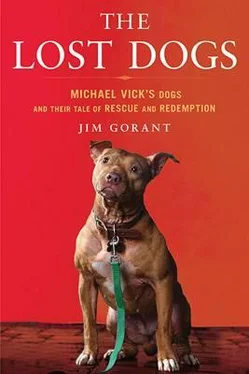Huss presented an interesting combination of skills. She was a recognized animal law expert with a corporate background, which meant she’d dealt with large organizations and had a certain level of polish to her work. To write her latest paper, she had taken a hard look at different rescue groups. She had a long history with animals, but no direct interest in how the Vick case would be resolved. Steve Z had put forward her name in late September.
She looked at the pink slip of paper one more time, dialed the number, and asked for Mike Gill. His mellow twang came over the line. He explained how he’d gotten her name and caught her up on where the case and the dogs stood. He told her that they were looking for someone to oversee the process that lay ahead, and he spelled out in detail what that process would be.
Finally, he asked: “Are you interested?”
Huss couldn’t say. She had long ago dismissed the case from her mind. She’d seen a few headlines, absorbed the gist of things, but had not followed the story. When news first broke she’d written it off as just another dogfighting case. They always ended the same way, with a bunch of dead dogs and very little justice. Just because there was a celebrity involved, she didn’t see how this would be any different.
Suddenly, the differences were coming toward her at a hundred miles per hour. Almost $1 million had been ticketed for the care and treatment of the dogs; individual evaluations had been conducted; recovery plans had been suggested and rescue groups would be screened. The process would require a lot of time and there would be criticism. It was the kind of issue that generated so much passion on either side it was unavoidable that someone would be unhappy in the end. She needed some time to think about the offer and to check with her Valparaiso colleagues, since some of the fallout and workload would hit them, too.
Huss spoke to her bosses and co-workers at the university, and everyone supported her taking on the assignment. A few days later she called back and accepted. An official motion was put before the court, and on October 15, Rebecca Huss was named guardian/special master of the forty-eight remaining pit bulls from Bad Newz Kennels.
She had been told that it would be best to provide the court with her final placement recommendations before Vick was sentenced in early December. That gave her roughly six weeks to evaluate the dogs, have them implanted with microchips, create an application and reach out to rescue groups and sanctuaries, solicit and screen applicants, allow the accepted groups to meet the dogs, decide which dogs were the best match for each group, and write up a report.
Huss had long ago thrown away the piece of pink paper that she’d found taped to her door three weeks earlier, but the sense of urgency that note foretold was just now beginning to become clear. It would be months before the feeling subsided.
IT WAS THIRTY-SIX HOURS after Rebecca Huss had agreed to be special master of the Vick dogs, and she was covered in every variety of canine excretion she cared to consider: saliva, blood, vomit, urine, feces. She knew that legal procedures sometimes got messy, but she never thought the law would lead her to a series of dances with pit bulls in sometimes antiquated shelters across rural Virginia.
The day after the court approved her as special master she had boarded an early morning flight from Indianapolis to Richmond. If she was going to have to individually place each dog, she knew the first order of business was to meet each dog.
She also needed to reassess their condition. It had been six weeks since the ASPCA team had met with the dogs. That was six more weeks of kennel life-of barking, of cramped quarters, of limited or sometimes no exercise or outside time, of scant attention and interaction with people or other dogs. All that came on top of four previous months locked up under similar circumstances. Would the ASPCA evaluations even hold up at this point?
Huss had spent a lot of time with dogs, but she knew those types of assessments were beyond her capabilities, so Tim Racer had also scrambled out to Virginia. Over the next three days, the pair spent time with every dog, getting each out of its pen for an extended period. They gave each one a chance to run on a leash, and at shelters that had an enclosed area, they set them loose. They observed each dog as it interacted with another dog. They played with the dogs, they held them and petted them.
Huss had never spent much time with pit bulls, but now that she was immersed in their world she couldn’t understand why they had such a bad reputation. In truth, the pit bull was simply a dog, imbued with all the positive and negative attributes of its kind. Just like any dog, pit bulls could be sweet, friendly, and loving, and they could also be unruly, ill-mannered, and prone to doing incredibly stupid things by human standards.
But for a number of reasons, pit bulls were the latest breed to get sucked into a self-fulfilling cycle of fear, hype, substandard care, and rising population. In the nineteenth century, a different breed of dog was considered so vicious and insidious that it inspired almost universal fear and loathing. That breed was the bloodhound. [3]
Every time a bloodhound was involved in an incident, accounts of their aggression filled news columns. Why? For starters, the term bloodhound had come to include many different breeds, not just the classic floppy-eared specimen that accompanies Scotland Yard detectives in TV movies, but any dog prized for its tracking and guarding abilities. There were Irish bloodhounds, Siberian bloodhounds, Cuban bloodhounds, and numerous others.
Many of those dogs were used to track escaped prisoners and slaves, guard stores, and protect homes, so they were encouraged to be aggressive and territorial. In the course of doing that work they often ended up in situations where they were pitted against people, and as one would expect, a fair share of those run-ins ended violently.
The bloodhound got a reputation as a fearsome beast with a taste for blood. That reputation stoked anxiety in the general public, and at the same time caught the attention of people attracted to the idea of having a tough dog. The bloodhound population increased, and the new owners were not raising their dogs to be family pets. Many of them wouldn’t have known how to properly train the dogs even if they’d wanted to. As a result many bloodhounds were ill-equipped to deal with people and new situations. This led to even more violent run-ins and more fear.
What finally turned things around for the bloodhound? Was it a sudden change in social attitudes or an improved understanding of the forces that created the problem to start with? No, it was the emergence of the German shepherd. These dogs arrived in the United States around 1910 and quickly gained a reputation as great guard dogs with an aggressive streak. Again, ironically, this reputation caused a population spike, particularly among the wrong type of dog owner. By 1925 there were so many German shepherds around causing so many problems that the borough of Queens, New York, proposed a ban on them. Australia banned them in 1929.
By the 1950s, the German shepherd-redeemed in the public’s mind by Rin Tin Tin-gave way to the Doberman pinscher, which had earned its fearful rep as the Nazis’ dog of choice during World War II. SS troops with Dobermans were a staple of war photography and the tales of what these dogs inflicted on concentration camp victims were well known.
In 1964 there were 4,815 new Doberman registrations filed with the American Kennel Club. By 1979 there were 80,363 new Dobermans registered, making it the second most popular breed in the United States. Although there were a few notable, well-publicized attacks, to the Doberman’s credit, the population spike did not result in a proportionate spike in incidents.
Читать дальше












